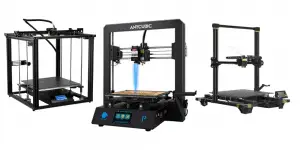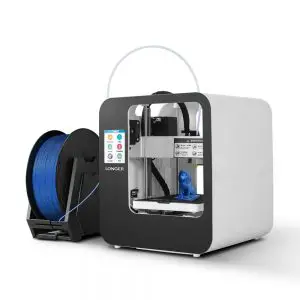Using a 3D printer opens up the possibility to create any number of objects. However, when you come across options like SLA vs FDM, how do you know which one is best? There are distinct differences between the two classes. Unless you understand how each type works, it is hard to choose the printer that will perform the way you want. Selecting the best choice means taking the time to learn how to operate and maintain both printers. Otherwise, you may find yourself spending hundreds of dollars to end up with a printer that takes too long or does not produce items with the quality you need.
What is SLA?

SLA is the short name for stereolithography. This process is not new. Since the 1980s people have used this process to create resin molds and models for a variety of purposes. Items begin as a liquid in a vat. The printer uses the fluid to draw a design that hardens to form a slice of material. Each slide gets added to the previous one. This printing method requires radiation to cure the material.
Printers using this system take a complex design file and use it to develop layers. To create each slice, a laser draws the shape into the pool of resin. As each layer prints, the laser beam causes a reaction with the chemical components of the liquid causing it to harden. This reaction forms models slice by slice. The printer dips the item in the liquid many times until the object is complete.
What is FDM?

FDM stands for fused deposition modeling. 3D printers use this technology to print materials like plastic layer by layer. The printer uses filament spools with metal, wood, or other components to create a solid object.
A single or dual nozzle system will heat up the substance and push it through the nozzles in an extrusion process. Each layer will settle onto the base and build the item. The printer works by moving along the x, y, and z axis’s printing in all three directions.
FDM technology does not use a laser or a curing process. The material must dry to form the layers and harden before the item is usable. This 3D printing process is the most popular for home use and creating simple items. FDM printers are commonly more accessible for the average person because they are affordable and the materials cheaper and easier to access.
Differences Between SLA and FDM
Each of these printers uses a unique process to create similar things. When comparing FDM vs SLA, there are several characteristics to point out. For instance, fused deposition modeling build layers on top of previous tiers while SLA technologies builds models in the opposite direction.
In SLA printing, the machine forms objects by taking them through multiple dunks in a tank of synthetic fluid. Each layer forms as lasers burn a shape into the fluid and make a thin section hard with successive dunks. The curing process requires a laser using ultraviolet light to harden the liquid on a molecular level. This reaction unifies the object making the finished product more solid than FDM models.

The cost to use and keep up these printers are vastly different. SLA technology requires the owner to buy more parts as the vat needs regular replacing. When the build platform gets gunk all over it and it is no longer easy to remove, then this part will need replacing too. Since each manufacturer offers a specific range or palette of colors, owners will pay more money for material costs.
FDM printers do not provide the same quality results as SLA printers, but they can print items faster when using the lowest setting. For example, a mold creating a common geometric shape might not look very pretty, but the object lets users make hundreds or thousands of the same item quickly.
SLA printers are better for the finer details. The more delicate or intricate the print requirements, the more important it is for users to choose the higher-quality technology. Removing finished parts might be important to picking as well. SLA printers often leave a sticky residue behind. The equipment is easiest to clean with a blade tool that scrapes this mess from the build platform. An alcohol solution will also do the trick, but experts suggest wearing gloves to prevent any skin irritation.
Both printers may leave residual material that the user must cut away from objects after the printing. The FDM technology may take more time to trim when complete because these plastic trees and holders are more common with this technology. Since the SLA components are sensitive to sunlight, using these printers for outdoor items is not a good idea.
Resin 3D Printer vs. Filament
SLA

- Creates layers only microns thick
- Uses a chemical curing process
- Builds stronger items than FDM models
- Proprietary color and resin options
- Regular problems creating objects with joints or hinges
- Cost and availability of parts and materials are limited
FDM

- An excellent option for novice printers
- Materials are less expensive than SLA parts
- FDM printers can often go faster than SLA equipment
- Does not make parts as precise as the stereolithography process
- Owners may spend a lot of time adjusting the nozzles and settings to get the results they want
SLA vs FDM: Which One to choose?
Both 3D processes use a layering or adding method to form objects. While each style of printing is vastly different, the end result is an object people can touch, use, and manipulate. Many people say there are two important factors to consider when you want to choose the right printer.
Affordability and quality may be what make up your mind. FDM printers are much cheaper to buy materials for, and the parts are not rare. SLA technology, however, creates a much smoother item. You will pay for this choice because it requires more frequent part changes than the FDM equipment.
When to Use SLA

When your job requires you to create precise models and prototypes, choosing the right 3D printing technology is crucial. Stereolithography technologies allow users to design items with specific details. The other models come out bumpy and uneven.
Mass production is another reason people choose these printers. The equipment builds intricate molds. Aircraft modelers and medical companies can use these objects during presentations and to communicate with others. For example, 3D models of various organs can help surgical students visualize the heart or lungs.
Molds for industrial parts like screws, proprietary parts, and other items help cut down replacement costs allowing companies to create these things in house. When you need to ensure clients get a screw with exactly 16 threads, or the lines must be a specific distance apart, getting the master mold right is imperative.
When to Use FDM

When contemplating a resin 3D printer vs filament technologies, material replacement costs are important. The latter printers only need owners to supply one item. The spools of filament are readily available, so this cost is negligible.
Since filament technologies use materials people can easily find, these printers are great for crafters. Whether you want to print miniatures, or you need a way to put your drawings to life, these printers work well. Hobby enthusiasts can easily learn how to use this technology to create everything from remote control airplane bodies to dollhouse furniture.
Final thoughts about FDM vs SLA technologies
Selecting the right printer for your needs will depend on a few things. Do you want an item that will stun your customers? Perhaps you need a rough idea of the shape and size of an object. If the price is important, then there is a lot to think about before you make your purchasing decision. Choosing between FDM vs SLA printers takes a bit of time and research, but the results are rewarding. Finding the right model can speed up manufacturing times or allow the user to make items that are not so easy to create by hand.




